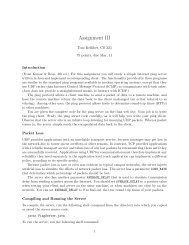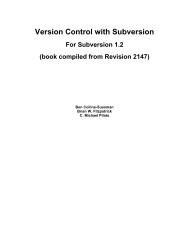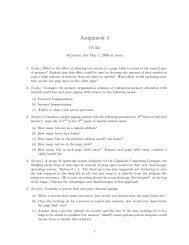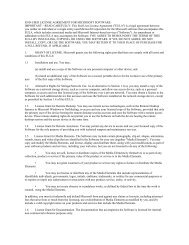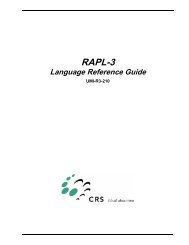Flesh and Machines - Phoenix Goucher
Flesh and Machines - Phoenix Goucher
Flesh and Machines - Phoenix Goucher
You also want an ePaper? Increase the reach of your titles
YUMPU automatically turns print PDFs into web optimized ePapers that Google loves.
than mere machines. Often the players are strong materialists who proclaim that they are not arguing for any role<br />
from God, or a spirit, or a soul for people, <strong>and</strong> not even some elan vital, or life force. Rather they argue that there is<br />
something explicitly or implicitly more than a mere machine but which is at the same time of the material world. In<br />
order to make such an argument they need to invent some sort of new stuff. Often they deny that this is what they are<br />
doing. Below, I pick Roger Penrose, David Chalmers, <strong>and</strong> John Searle as representatives of the people who provide<br />
the most cogent arguments against people being just machines. Penrose <strong>and</strong> Chalmers could turn out to be right,<br />
although neither of them provides any data to support his hypothesis. Searle, I think, is just plain confused.<br />
Roger Penrose, the British physicist <strong>and</strong> mathematician, is certainly a hard-nosed scientist. He has written a number<br />
of books that attack artificial intelligence research as not being likely to build intelligent, conscious machines. While<br />
he might be right about that, his arguments are flawed <strong>and</strong> are certainly good examples of a "new stuff argument.<br />
Penrose starts out by making a mistake in underst<strong>and</strong>ing Godel's theorem <strong>and</strong> Turing machines. Kurt Godel shocked<br />
the world in the thirties by showing that any consistent set of axioms for mathematics had theorems that could not be<br />
proved within that set of axioms. Turing machines, the formalization of modern computers that Alan Turing came<br />
up with around the same time, operate within whatever set of axioms they are given. So combined, these two results<br />
say that there are true theorems within mathematics that a computer cannot prove to be true. So if human<br />
mathematicians were computers, there would be theorems that they could not prove. This rankles Penrose's pride in<br />
himself <strong>and</strong> his friends. They are all able to prove lots of theorems, so Penrose incorrectly concludes that humans, or<br />
at least mathematicians, cannot be computers.<br />
Now Penrose is in a fix. He is a hard-core materialist, but the material world cannot explain what he thinks he has<br />
observed. He needs to find something new to add within the material world that is outside the realm of ordinary<br />
computers. He hits upon the microtubules inside cells where there are quantum effects in operation. He<br />
hypothes izes, with no data to support his hypothesis, that the quantum effects there are the source of consciousness.<br />
Rather than accept the idea that consciousness is just an extension of the ideas we described in chapter 3, the result<br />
of simple mindless activities coupled together, Penrose asserts that there is some inexplicable extra thing, quantum<br />
mechanics, at play in living systems.<br />
Penrose, in his bid for scientific materialism, has resorted to a mysterious higher force. Rather than accept the<br />
offensive idea that his magnificent mind is the product of simple mechanisms playing out together, he calls into play<br />
something too complicated for us to underst<strong>and</strong> fully He invents his own little deity, the god of quantum mechanics.<br />
David Chalmers, a philosopher at the University of Santa Cruz, is another hard-nosed materialist. He invents a very<br />
different type of "new stuff." In his version there may be some fundamentally new type in the universe that we have<br />
not yet observed directly He compares it to spin or charm in particle physics—properties of subatomic particles.<br />
Neither of these can be reduced to mass or charge, or any of the more usual types we have come to underst<strong>and</strong> from<br />
classical physics. In his theory there is perhaps another type like these that we cannot observe directly with our<br />
senses, just as we cannot observe spin or charm. This new type may then be the basis of consciousness. Again, we<br />
see an appeal to some sort of higher authority, something different from anything that is rule-based, or<br />
mechanismlike. Chalmers appeals to something mysterious <strong>and</strong> not understood so that he can save his materialist<br />
view of the world without having to give up his specialness, to be nothing more than a mere machine.<br />
John Searle is a very well respected philosopher at Berkeley. He professes to believe that mind <strong>and</strong> particularly<br />
consciousness is an emergent property of our having a brain inside our skulls. He claims to be interested in scientific<br />
explanations. But deep down he reveals that he is completely unable to accept that anything but real neurons can<br />
produce consciousness <strong>and</strong> underst<strong>and</strong>ing. He occasionally admits as much, for example:<br />
In this case, we are imagining that the silicon chips have the power ... to<br />
duplicate the mental phenomena, conscious <strong>and</strong> otherwise. . . .I hasten to add<br />
that I don't for a moment think that such a thing is even remotely empirically<br />
possible. I think it is empirically absurd to suppose that we could duplicate the<br />
causal powers of neurons entirely in silicon.<br />
Beyond this his arguments get circular, although I am sure he would rather pejoratively disagree with my analysis<br />
here. His arguments are largely of the form of imagining robots <strong>and</strong> computer programs that have the same inputoutput<br />
behaviors as animals or people, <strong>and</strong> then claiming that the (imagined) existence of such things proves that<br />
mental phenomena <strong>and</strong> consciousness exist as a property of the human brain, because the robot has neither of them,<br />
even though it is able to operate in the same way as a human. This argument as I have related it may not make sense<br />
to you, but I think it is a fair summary of Searle's position. And I think the real basis for his arguments, deep down,



